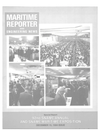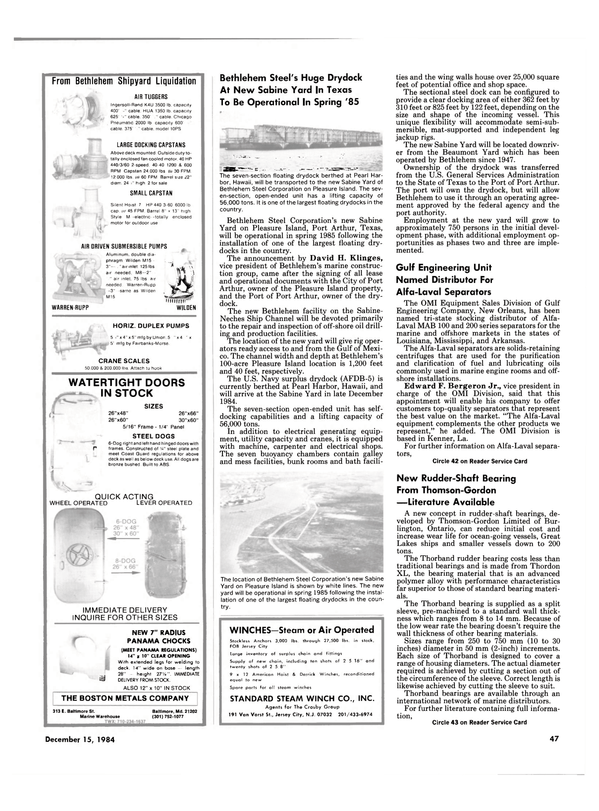
C. Plath Offers Literature On NAVIGLOBE Satellite Navigation Receiver
C. Plath of Hamburg, West Germany, a division of Litton Industries, Inc., is offering literature on NAVIGLOBE, the Global Positioning System (GPS) satellite navigation receiver that was the center of interest at their stand during this year's International Ship, Machinery and Marine Technology Exhibition in Hamburg.
The informative literature explains what the Global Positioning System is, how it works, and how GPS user equipment processes pseudorange measurements and satellite positions to estimate threedimensional user position and time.
Features and performance of the NAVIGLOBE are discussed and technical data is listed, such as navigation signal, dynamic capability, interference immunity, reaction time, accuracy, interfaces, dimensions, power requirements, etc.
The publications points out that the main advantage of the NAVIGLOBE, which was developed within the Litton Group by C. Plath in cooperation with a sister company, is its layout for simple operation: without knowledge of the operator's position, time special chart or calibration, NAVIGLOBE will indicate continuously its position with highest accuracy, shortly after switching.
Photos of the NAVIGLOBE control display unit and receiver processor unit are included.
For a free copy of the literature and more information on the NAVIGLOBE GPS satellite navigation receiver, Circle 20 on Reader Service Card
Read C. Plath Offers Literature On NAVIGLOBE Satellite Navigation Receiver in Pdf, Flash or Html5 edition of December 15, 1984 Maritime Reporter
Other stories from December 15, 1984 issue
Content
- Webb Elects Officers To Governing Board— Bryan Named President page: 5
- Brown Brothers Appoint New Marketing Director page: 5
- Huthnance Corporation Formed To Consolidate Rig Ownership page: 6
- Brochure On Halon 1301 Fire Extinguishing Systems Offered By Walter Kidde page: 6
- Bay Ship Converts NavAids Barge For U.S. Coast Guard page: 6
- Annual Conference Of CSSRA Scheduled For February 18-19, 1985 page: 6
- Lindenau Yard Delivers Seismic Research Vessel To Western Geophysical page: 7
- NMEA Plans to Expand Electronics Technician Certification Program page: 7
- Hose-McCann Introduces Dial Telephone System page: 7
- USCG License Preparation Quicker And Easier With Computer-Aided System page: 8
- Seebeckwerft Delivers World's Largest Railway/Car Ferry page: 8
- Magnavox Announces First Fully Automatic Vessel Monitoring System page: 8
- Magliocca Elected New General Chairman Of NSC Marine Section page: 9
- BFGoodrich Offers New Brochure On Cutless Line Of Rubber Bearings page: 9
- Training Success With U.S. Rig Simulator Featured At Conference page: 10
- Borum Wins Kings Point Outstanding Professional Achievement Award page: 10
- Offshore Shipbuilding Delivers Passenger/Vehicle Ferry page: 11
- Exxon Research Offers To License Computerized Machine Analysis System page: 11
- Marine Applications Book Availble From Sandusky page: 13
- Avondale Shipyards Holds Keel-Laying Ceremonies For First Of Four Navy Fleet Oilers page: 13
- Robins Named Managing Director-Business Operations At Rolls-Royce page: 13
- Containership 'Merzario Britannia' Launched At Fincantieri Yard page: 14
- N.F. Pergola Appointed Manager-Marine Personnel At Energy Transportation page: 14
- Murray Named Executive Director Of St. John Port Development Commission page: 14
- Regency Introduces The CR5000 Electronic Chart Recorder page: 14
- K-C Offers Literature On Replacement Parts Line For GM Diesels page: 16
- WABCO Westinghouse Offers Free Booklet On Controls For Ships page: 16
- Crouse-Hinds Offers Literature On Lighting Fixtures & Others Products page: 17
- Ursini Appointed Vice President-General Manager Of Skagit Products page: 17
- The 92nd SNAME Annual Meeting A Special Post-Meeting And Exposition Report page: 18
- Cable Splicing System Lowers Shipbuilding Costs page: 23
- New Literature Available On VHF/FM Marine Radios From Uniden Corporation page: 26
- Hahnfeldt Appointed Power Division Sales Manager At H.O. Penn Machinery page: 26
- Todd-Los Angeles Delivers Guided Missile Frigate FFG-51 Gary To U.S. Navy page: 28
- Ryan-Walsh Appoints John McCarron Jr. Chief Executive Officer page: 28
- Koomey Announces Management Changes—Dumas Named President page: 30
- ASNE Establishes Dr. James A. Lisnyk Memorial Scholarship page: 30
- Navy Awards E-Systems $40-Million Contract page: 30
- Rexnord Announces Formation of Process Controls Division page: 30
- Du Pont's Maintenance Painting Service Lowers Costs On Offshore Platforms page: 32
- Morgan Appointed National Sales Manager For Welded Beam page: 33
- John Gaughan Named To New Maritime Post page: 33
- Taylor Joins COMSAT World Systems Division As Senior Vice President page: 34
- Todd Marine Systems Offers New Brochure On Combustion Technology page: 34
- Torpedo SPC Chosen For Advanced Cable Layer page: 34
- Corpus Christi Bulk-Loading Facility To Be Modernized page: 35
- New Full-Color Brochure Available From PACECO page: 36
- Daewoo Gets $425-Million Contract From Sonat For Six Semisubmersible Rigs page: 36
- Whalen Joins Huthnance As Vice President -Operations page: 36
- Liner Norway Fitted With New MaK-Driven Gensets page: 37
- MarineSafety Offers Radar Renewal Course page: 37
- Crosby Group Adds New Block To Product Line page: 37
- Regency Introduces Marine Television/FM Stereo Antenna And Amplifier page: 38
- Newman's Introduces NEWCO Marine Valves page: 38
- Rockwell Offers Brochure On Ship Information Management Systems page: 38
- Markey Delivers DESH-6 Electric Research Winch page: 38
- C. Plath Offers Literature On NAVIGLOBE Satellite Navigation Receiver page: 43
- Free Literature Offered On Walter Kidde Marine Smoke Detection System page: 43
- Imperial Survival Suits Offered by Alexander page: 43
- Phoenix Introduces Sodium Fishing Lights page: 43
- Tano Corporation Offers New Brochure On Marine Automation Systems page: 44
- SNAME Announces 1985 Scholarships In Graduate And Undergraduate Levels page: 44
- Bethlehem Steel's Huge Drydock At New Sabine Yard In Texas To Be Operational In Spring '85 page: 47
- New Rudder-Shaft Bearing From Thomson-Gordon page: 47


